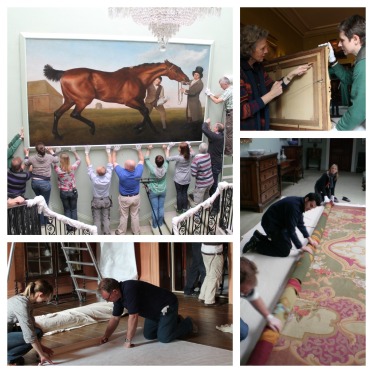Hi all,
So what has been happening on the conservation front at Mount Stewart? Well in the last five weeks we have been fully booked in Hague our conservation studio, we have had glass chandeliers, gilt floor lights, doors, floor skirting boards, altar hangings and pelmets which have had their turn in ‘hospital’ this month, all coming out in ‘good health’ in a much improved condition.
In the first two weeks of May we had Terry Brotheridge – freelance lighting specialist onsite continuing the re-wiring all of our fixed light fittings housed at Mount Stewart. I attempted to work out the precise number of lights he is working on and after counting seven chandeliers and over sixty wall lights I succumbed to averaging that we have over 120 fixed lights. This does not account for the free standing table lamps and floor lamps we have in the collections which are also being rewired; Richard from Irwins (our electrical contractors) is carrying out the careful re-wiring of these. He had to undertake a rigorous test in conservation object handling, administered and scored by myself and our House and Collections Manager before he was entrusted and able to work on the lamps. He passed with flying colours and to date has re-wired around 180 free standing lamps from our collection!
All of the lights across the property are having their bulb/lamp holders changed from bayonet fittings to screw-in, so no downward pressure will be placed on the arms of the lights when these require changing or cleaning in the future, this is how breakages have occurred in the past. The wiring on all the lamps is being upgraded to double insulated, clear, 3 core wire with earthed lamp holders, in which new LED bulbs/lamps will be fitted. LED lamps last longer and emit less heat than a tungsten bulb/lamp, reducing damage to the object and surrounding collections, as well as being energy efficient. These new amendments will ensure that the lamps, wall lights, and chandeliers are preserved for future generations as we will no longer run the risk of scorching our delicate lampshades and breaking delicate, glass and gilt wooden arms from our chandeliers.
So to continue….
Mid May Fergus Purdy – furniture conservator paid us a visit in Hague; he worked on numerous skirting boards and doors from the upper floors of the west end of the house, removing inlays which had suffered from woodworm damage and old repairs which have failed. He then cleaned the items and fitted new sections of wooden inlay and veneers, staining and waxing them to match the original item. Fergus will be back working in Hague (conservation studio) 9 June through to 20 June, Monday to Friday; do come and visit Hague and see his fabulous work!
On Friday 23 May, the doors were moved out of Hague in order to create space for four textile hangings and eight pelmets to be laid out on the benches in preparation for assessment this week by Melanie Leach, one of our freelance textile conservators. Many of the textiles at Mount Stewart have deteriorated over the years, they are one of the most delicate and susceptible materials to light damage, surface dirt accretion and wear and tear. As many of our textiles hang, it is important that they are conserved, to ensure that they do not suffer and fail under their own weight. Many of the textiles are also undergoing deep cleaning to remove all the dust and debris which has accumulated over the years; this entails careful conservation vacuuming carried out by our project conservation volunteers all trained in this specialist cleaning method. In some cases further work such as wet conservation cleaning and repairs are required, these are all carried out by our specialist textile conservators, both offsite and in Hague. Holly (one of our volunteers on the textile team) will update you on more works which have been occurring.

Melanie Leach showing the project conservation volunteers how to carry out dry conservation vacuuming of textiles
This week (start of June) we have Graeme Storey ‘taking the reins’ in Hague, he is a specialist in the conservation of paper and will be here for the week working on our vast collection of paper/vellum lampshades, only about 180 in our collection of which Graeme will be assessing and working on. Wish him luck!
As for the rest of the team, Christina, myself, the project volunteers and house team volunteers, we’ve been enjoying tea and cake whilst the conservators have been working hard in Hague….…. If only!! No, we’ve been working hard, moving collections out of storage for conservation works, returning them to storage once works are complete, continuing with the careful cleaning of the vast collection of textiles in the house, packing collections going away for conservation, monitoring the collections in store, cataloging and organising collections in storage……..all in preparation for THE REINSTATEMENT!!!
DUN DUN DAH!!
Take a quick peak at our some of the collections in store.
We have already nearly completed reinstatement of items in the family’s private rooms, currently reinstating their collection of books. The reinstatement of the main rooms across the house will be starting this summer……..so… if you are currently volunteering within the property or have experience in handling collections in the museum sector or similar and wish to join the project conservation team, we have a role for you here!
I think we are now up to date with conservation works at Mount Stewart, it has been a busy month, yet quiet and peaceful as we have not seen or heard the joiners in weeks! They’ve been hiding from us in the west end of the house!
Next month’s happenings coming soon……..
Lauren








